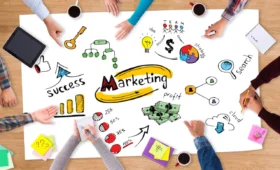Marketing is an ever-evolving field that constantly adapts to new technologies, consumer behaviors, and business needs. As we approach 2025, several emerging trends and innovations will redefine how businesses connect with their audiences. From artificial intelligence (AI) and personalized experiences to the rise of immersive technologies like virtual reality (VR) and augmented reality (AR), the future of marketing promises exciting opportunities. Let’s explore the key marketing trends, strategies, and tools you can expect to dominate the industry in the coming years.
1. AI and Automation in Marketing
Artificial intelligence and automation are already transforming marketing, and by 2025, they will be even more central to marketing strategies. AI-powered tools will enable brands to automate repetitive tasks, allowing marketers to focus on higher-level strategic work.
Chatbots, personalized recommendations, and AI-driven content creation are just the beginning. AI will be used to analyze vast amounts of data to predict consumer behavior, create customized campaigns, and optimize ad placements. Additionally, machine learning will allow brands to deliver content at the perfect time to the right audience, boosting engagement and conversion rates.
Automating customer service, content creation, and even social media management will also make marketing efforts more efficient, reducing operational costs and improving the customer experience.
2. Personalization at Scale
Personalization will be more important than ever in 2025. Consumers expect relevant, tailored content across every touchpoint of their journey. With advancements in data analytics and machine learning, brands will have the ability to personalize experiences on a much larger scale.
Whether it’s through personalized emails, dynamic website content, or custom-tailored social media ads, marketing efforts will become more individualized. Personalization will not only be about addressing customers by name but about predicting their needs and offering them the right products or services before they even ask.
Brands that embrace data-driven marketing will be able to segment audiences effectively, creating content that speaks directly to specific groups. This approach will increase customer satisfaction, drive loyalty, and ultimately lead to better ROI.
3. Voice Search and Conversational Marketing
The rise of voice assistants such as Amazon Alexa, Google Assistant, and Siri has already begun to influence marketing strategies. By 2025, voice search will become even more prevalent, and marketers will need to optimize their content for voice queries.
Conversational marketing is also on the rise. As consumers increasingly turn to messaging apps, chatbots, and voice assistants, businesses will engage with customers in real time to answer questions, provide recommendations, and resolve issues. Conversational marketing tools like live chat, automated responses, and interactive voice response systems will play a critical role in building direct, personalized connections with customers.
4. Influencer Marketing Continues to Evolve
Influencer marketing has seen explosive growth in recent years, and it’s only going to expand in 2025. However, as the industry matures, we’ll see a shift from celebrity influencers to more micro and nano-influencers, who have smaller, but highly engaged, followings.
Brands will increasingly partner with these influencers to reach niche audiences in an authentic and relatable way. Influencers will not only be limited to social media platforms like Instagram or YouTube but will also expand into new digital spaces such as the metaverse, where brands can create virtual influencers or host interactive experiences.
The future of influencer marketing will involve building long-term relationships with influencers who genuinely align with a brand’s values and message. Authenticity will become key, as consumers become more discerning about the products and services being promoted.
5. Video Marketing and Livestreaming
Video marketing has become a central component of digital strategies, and by 2025, its importance will only continue to grow. Live streaming will be an especially critical tool for real-time engagement. Brands will host live Q&A sessions, product reveals, behind-the-scenes content, and more to connect with their audiences in real-time.
Shoppable videos and interactive video ads will take video marketing to the next level. These formats allow viewers to click on products featured in the video and make purchases directly through the platform, creating seamless shopping experiences.
In addition, short-form videos, like those seen on TikTok and Instagram Reels, will continue to dominate. With their ability to quickly capture attention and convey information in creative ways, short-form video will be a powerful tool for brands looking to increase engagement and drive conversions.
6. Augmented Reality (AR) and Virtual Reality (VR)
By 2025, AR and VR technologies will be widely adopted by marketers to create interactive and immersive experiences. These technologies will revolutionize how brands engage with customers and present their products.
Augmented reality will allow consumers to virtually try on clothes, preview furniture in their homes, or experience products in their natural environment. This technology will bridge the gap between physical and digital shopping, offering customers a more engaging and personalized experience.
Virtual reality will enable brands to create fully immersive experiences, such as virtual store tours or product demonstrations. For example, travel brands may offer virtual vacations, while automotive companies may allow potential buyers to take virtual test drives.
By incorporating AR and VR into marketing campaigns, brands can offer unique, interactive experiences that increase engagement and provide real-time value to customers.
7. Sustainability and Ethical Marketing
As consumers become more socially and environmentally conscious, sustainability will be a key factor in purchasing decisions. By 2025, ethical marketing will be at the forefront of brand messaging, as consumers demand transparency, sustainability, and responsible practices.
Brands that embrace sustainable practices, such as eco-friendly products, ethical sourcing, and carbon-neutral production, will appeal to consumers who prioritize environmental and social responsibility. Marketing campaigns will highlight these efforts through storytelling and transparency, building trust with a growing base of environmentally conscious customers.
Additionally, brands will increasingly focus on diversity and inclusion in their marketing efforts. Inclusive messaging, diverse representation, and ethical practices will be a must for companies looking to resonate with today’s socially aware consumers.
8. Data Privacy and Consumer Trust
As privacy concerns continue to rise, data protection will be a top priority for marketers. By 2025, consumers will expect businesses to be more transparent about how their data is collected, used, and protected.
Marketers will need to adopt a privacy-first approach, ensuring they comply with regulations such as the General Data Protection Regulation (GDPR) and the California Consumer Privacy Act (CCPA). Offering consumers clear and accessible privacy policies, as well as giving them control over their data, will build trust and help brands maintain positive relationships with their audience.
Brands that prioritize transparency in their data practices will stand out from competitors and earn the loyalty of privacy-conscious consumers.
9. Programmatic Advertising
Programmatic advertising, the use of AI and automated technology to buy and place ads, is already a major player in digital marketing. By 2025, programmatic advertising will become even more sophisticated, enabling real-time targeting and more personalized ad experiences.
With programmatic advertising, marketers can automate the buying and placement of digital ads across multiple platforms, targeting consumers with precision based on their behavior, interests, and preferences. This will allow brands to deliver more relevant ads, optimize their ad spend, and improve ROI.
As machine learning continues to evolve, programmatic advertising will become even more efficient, allowing brands to make adjustments to campaigns in real-time and maximize their marketing efforts.
10. The Rise of the Metaverse
As technology continues to advance, the metaverse—an interconnected virtual world—will emerge as a new frontier for marketing. In the metaverse, brands will create virtual spaces where users can interact with their products, attend events, and experience immersive environments.
For example, a clothing brand might host a virtual fashion show or a tech company might create a virtual space where customers can explore its latest gadgets in a 3D environment. By 2025, brands will increasingly look to the metaverse to engage with younger, tech-savvy audiences and offer new, interactive experiences.
Conclusion: Preparing for the Future of Marketing
As we approach 2025, the marketing landscape will be shaped by new technologies, evolving consumer behaviors, and a focus on sustainability and authenticity. Brands that stay ahead of these trends and embrace innovation will be well-positioned to succeed in an increasingly competitive digital world. By leveraging AI, personalization, immersive technologies, and ethical practices, businesses can create meaningful connections with their audiences, drive growth, and build lasting relationships.




